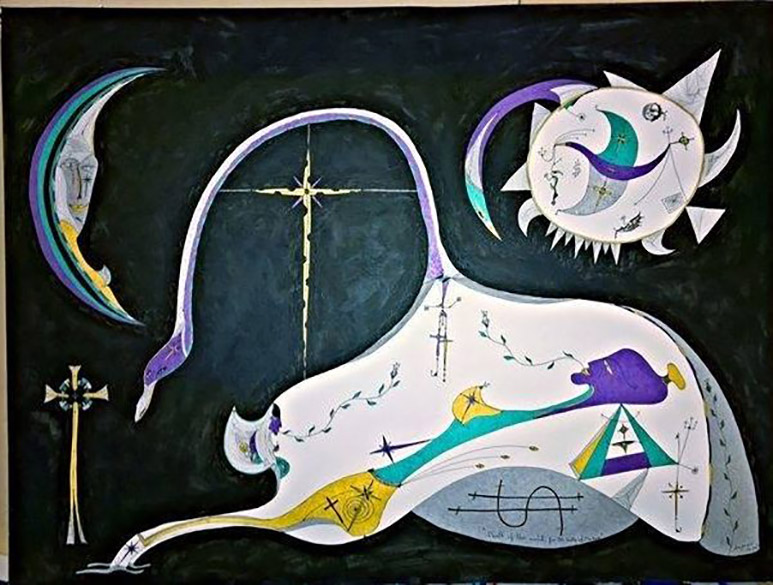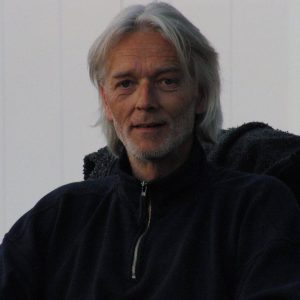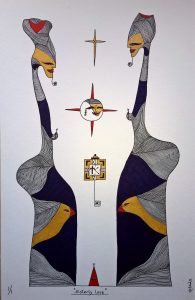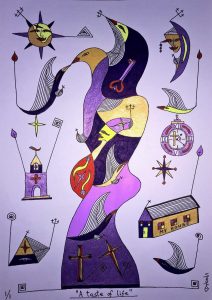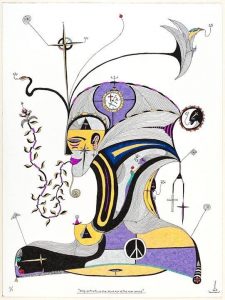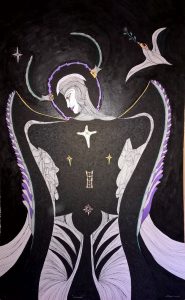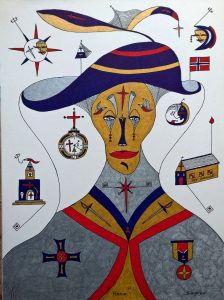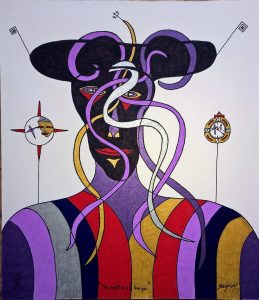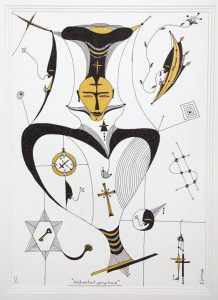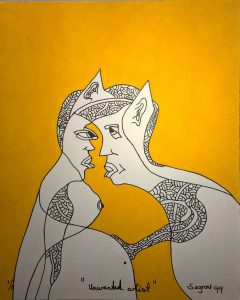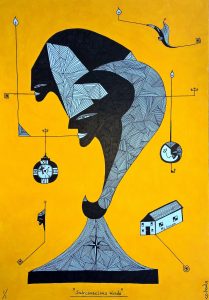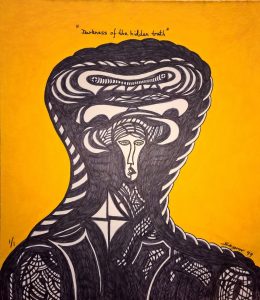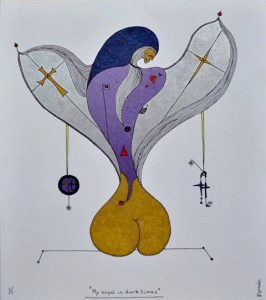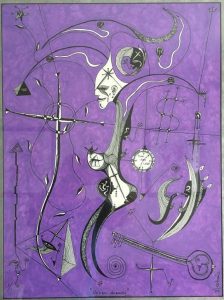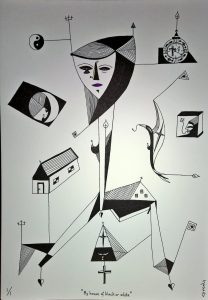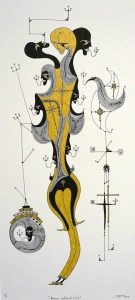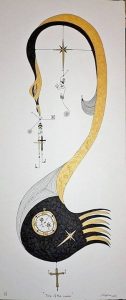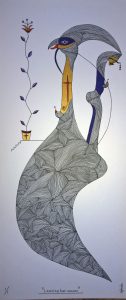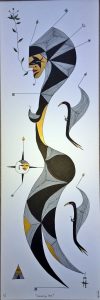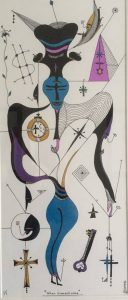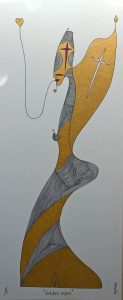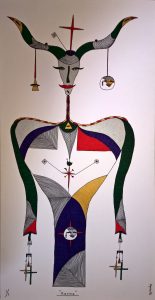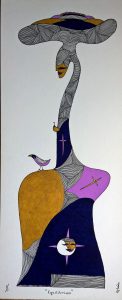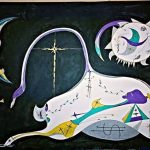Helge Segrov in an educational perspective
Helge Segrov is an artist with many different expressions; from paintings to sculptures to drawings full of symbols. In addition he writes poems, so it's a versatile artist we are dealing with.
Except from the poem "My life" which is rendered here , we will in this post concentrate on the drawings. Since several of the drawings have been used by myself in teaching, it will all be put into an educational perspective. A more detailed presentation of both the artist and the art will come at a later time.
"My life "
Poorly comfort hungry mind deeply scared transparent skin fragile feet with careful steps on lonely paths in thorny bush I seek my way my backyard life collecting strength with bloody hands I ware a cape of moth-eaten hope passed to me from father's hand but see my heart is woven strong with treads of silk my children's work it lifts me up and back to life until I naked to sunset walkWe will not go into further interpretation here, just say that the poem is well suited for use teaching in literature where modernism has a central place. One possibility is to compare it with James Joyce's Ulysses, or T.S. Eliot's The Waste Land just to have mention some. In addition the students can point at modernist traits finding in the poem.
The text is also usable in the way of seeing what elements the poem is made up from and the literary techniques that are used to create the image of the lyrical I. Making a discourse analyses can also be productive, but this is just some suggestions, there may be many other ways using this poem in teaching.
"Enter my mind"
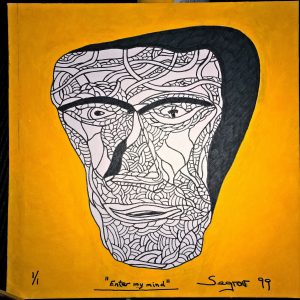 Looking at the work "Enter my mind" from 1999 where the yellow background is added afterwards, it is not an easier mind we are going to meet. We see a head with a complicated pattern that gives the impression of being inside the head. Although the pattern is complicated, the eyes, nose and mouth are clearly defined. Rear part of the skull is black, which creates a contrast to the rest, apart from the small fields that marks eyebrow and slightly nasal bone.
Looking at the work "Enter my mind" from 1999 where the yellow background is added afterwards, it is not an easier mind we are going to meet. We see a head with a complicated pattern that gives the impression of being inside the head. Although the pattern is complicated, the eyes, nose and mouth are clearly defined. Rear part of the skull is black, which creates a contrast to the rest, apart from the small fields that marks eyebrow and slightly nasal bone.
With modernism the fragmented man came in focus; man made up of many facets, and in many ways this work can be seen as a symbol of how complicated the human mind is. The work is well suited for lessons in several subjects; as a starting point for discussions on the human mind, communication between people, etc. etc.
"Talking heads"
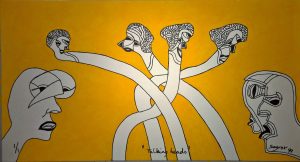 "Talking heads" from 1999 where the yellow background is added afterwards, is a work that the undersigned has used in communication and culture courses with good results. The work consists of a total of seven heads where two are located right in the picture, another is located to the left, while the last four in one way or another are intertwined and are at a higher level in the image. The heads are highly abstract but still very different and with different expressions, and it was the composition and terms that led to the good and enthusiastic discussions among the students. Keywords are hierarchical, non-verbal communication, culture filter, cross-culture communication, culture crashes, adventure, etc. etc. In addition the students were very concern with how the artist promoted the different expressions; what it was that made them reading the expressions the way they did.
"Talking heads" from 1999 where the yellow background is added afterwards, is a work that the undersigned has used in communication and culture courses with good results. The work consists of a total of seven heads where two are located right in the picture, another is located to the left, while the last four in one way or another are intertwined and are at a higher level in the image. The heads are highly abstract but still very different and with different expressions, and it was the composition and terms that led to the good and enthusiastic discussions among the students. Keywords are hierarchical, non-verbal communication, culture filter, cross-culture communication, culture crashes, adventure, etc. etc. In addition the students were very concern with how the artist promoted the different expressions; what it was that made them reading the expressions the way they did.
"Springtime voyage"
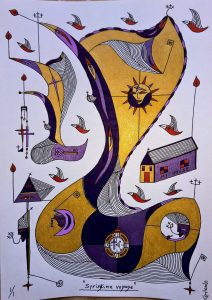 "Springtime voyage" from 2015 is one of the works with many symbols. Art historically it is natural to associate the work to symbolism; even though it took place towards the end of the 1800s. However we will leave it until later, and rather go into detail on elements that the picture is built up of. In the center of the picture we find a mixture of a bird and a boat; the top part may have the form of a sail, while the forward part has the shape of a bird with elongated neck, eyes and beak. The bottom part can symbolize the boat or the body of the bird, which give an ambivalent expression, which we can find in several of Helge Segrov's expressions, but we will return to it later. The predominant colour is ocher, but we also find darker portions where it is used two shades of purple. Also featured are parties where it is drawn a neat pattern. The lower form has a sort of tripartite where the middle portion has purple as a base colour and a symbol that resembles a clock with a cross inside, while the other two parts have ocher background colour and one part has a symbol that resembles a crescent with a face in front. The third and last part has a face within a circle and more crosses. To the left of the main subject the shape is repeated in a smaller size without being a true copy. Here the bird is separated from the sling and carrying two crosses, and in the lower part of the figure we find dichotomy where the neat pattern is repeated in one section while the other part has a key. We also find other elements in the picture; like a pyramid associated with a face, a house with the inscription "MY HOUSE" and many small birds evenly throughout. The final element is the "so-called" flags with different subjects like spiral, square, or the red end pieces. The composition enables all elements together forms a whole in balance.
"Springtime voyage" from 2015 is one of the works with many symbols. Art historically it is natural to associate the work to symbolism; even though it took place towards the end of the 1800s. However we will leave it until later, and rather go into detail on elements that the picture is built up of. In the center of the picture we find a mixture of a bird and a boat; the top part may have the form of a sail, while the forward part has the shape of a bird with elongated neck, eyes and beak. The bottom part can symbolize the boat or the body of the bird, which give an ambivalent expression, which we can find in several of Helge Segrov's expressions, but we will return to it later. The predominant colour is ocher, but we also find darker portions where it is used two shades of purple. Also featured are parties where it is drawn a neat pattern. The lower form has a sort of tripartite where the middle portion has purple as a base colour and a symbol that resembles a clock with a cross inside, while the other two parts have ocher background colour and one part has a symbol that resembles a crescent with a face in front. The third and last part has a face within a circle and more crosses. To the left of the main subject the shape is repeated in a smaller size without being a true copy. Here the bird is separated from the sling and carrying two crosses, and in the lower part of the figure we find dichotomy where the neat pattern is repeated in one section while the other part has a key. We also find other elements in the picture; like a pyramid associated with a face, a house with the inscription "MY HOUSE" and many small birds evenly throughout. The final element is the "so-called" flags with different subjects like spiral, square, or the red end pieces. The composition enables all elements together forms a whole in balance.
Symbolism
As previously mentioned, it is natural linking many of these works, including this one, to symbolism art historical, all though it took place towards the end of 1800s. Symbolism came as a reaction towards realism and naturalism which was concern with the external reality, while symbolism was concern with the inner of man. Sigmund Freud, father of psychoanalyses, had yet a big impact of the symbolists, without going further into psychoanalyses of Freud here. The Norwegian author Knut Hamsun was also concerned with the inner of man; the unconscious mind: "...these thoughts and emotion's wandering in the blue, steps resolve, clueless traveling with brain and heart, strange nerve business, the whispering of blood, the prayer of the bones, all the unconscious psyche" (freely translated) 1)From Hamsun's "The unconscious psyche" which was a protest against realism and naturalism
The symbolism however had no coherent expression in art. In 1891 Albert Aurier (1865-92), which was a symbolic poet himself, wrote the article "Symbolism in painting - Paul Gauguin" where he highlighted five main points:
1) Idea embossed, because its sole aim will be to express an idea, and 2) symbolic, since it will express this idea by gander of forms; 3) synthetic as it will presents these forms, , these characters, in an universally understandable manner; 4) subjectively when the object of art depicts, will never be considered only as an object, but as a sign of an idea conceived of the self. 5) decorative, for the decorative painting is nothing but a manifestation of the art, which at the one time is subjective, synthetic, symbolic and idea embossed". (freely translated from danish) 2)Dreyers kunstleksikon 11 side 110
As we see Paul Gauguin is among the artists who are considered among the symbolists. "Jakob's struggle with the angel - vision after the Mass" from 1888 is one og Gauguin's famous work which is usually presented as synthetism; see point tree of Aurier's main point. Other notable symbolists are Van Gogh, Edvard Munch; Gustav Klimt, Odilon Redon, just to name a few. They sought a return to the archaic, the real, the original. Carl Jung, who was a student of Sigmund Freud, was concerned with archetypes, so we can in many ways with Hegel say that it was a Zeitgeist when the symbolism took place.; quest towards the mind and the original was the main thing at the time. Something coherent expression can not be assumed in symbolism, but the archaic, the use of gold and winding decorative lines is something that recurs. Looking at the artist Gustav Klimt, we associate him with the use of gold and the decorative. He is mainly placed as an artist of Art Nouveau or Jugendstil, but the symbolism in many ways proceed to the Jugendstil.
Helge Segrov og Symbolism
As mention earlier, symbolism took place towards the 1800s, but that doesn't mean that we cannot link artworks from today to symbolism. Looking at "Springtime voyage" it is a work packed with symbols. If we tie it up against Aurier's main points we can tick off several of them:
Point 1; What idea is it Segrov will express here? It is very aesthetic and in good balance, and out of that we can maybe conclude that the artist's idea is all about promoting the beautiful and the good in life? The artist himself has stated that he is concerned about the good to win over evil.
Point 2; The shape used by the artist are sacred symbols and organic forms,; forms that are associated with the female, the natural, and the soft values, in a balanced composition.
Point 3; The artist is using symbols and shapes which easily should be understandable for most.
Point 4; We can also tick off for the subjectivity of the image; the artist has his own special way of expression himself; the sun can be an example.
Point 5; Most people can agree on the decorative of the image.
As seen, we can tick off all of Aurier's points when we are dealing with "Springtime voyage", but does it mean that Segrov belongs in symbolism? Hardly, as we said; there are over hundred years since symbolism took place and the time "Springtime voyage" was created, and although a lot fits Aurier and his criteria, we find a greater difference when it comes to the artists. Most of the pictures are decorative, have organic forms, and often sacral symbolism, like "Springtime voyage", but while Segrov is using crosses, house, birdlike and humanoid creatures in his symbolism, artists like Gustav Klimt used the gold to create the sacral expression as well as people who admittedly are abstract, but not to the extent Segrov's creatures are. Helge Segrov however has stated that Gustav Klimt is one of the artists he is inspired by, so perhaps this isn't an unnatural comparison? When it comes to Munch and his painting Skrik (Scream) the difference is even greater. Skrik is often located within the expressionism, but it has both organic forms and the winding decorative lines, the colours are primarily doing this work expressionistic. However one shall remember that its not the artists that place themselves within the different -ism, there are others that take care of that, and most of the artists can be placed within different -isms or periods, but there are also many artists who can not be placed within any particular period; whether artists of yesteryear or contemporary artists. Regarding Helge Segrov, he is quite alone in the special expression we find in his drawings, and even today when we still find us in what is called postmodernism, it becomes too easy to call him a postmodernist with all it implies. The artist has traits from both symbolism and surrealism, and one can finally say that he is an expressionist, but why do we have to put an artist within an -ism?
"Springtime voyage" and "Death of this world for the birth of the new" in teaching.
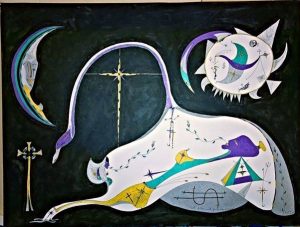 In a teaching situation it could be fruitful to put Helge Segrov's art into an art historical context and then feel free to link it to the symbolism as been done here. Another option is to use the art in teaching religion and ethic. Divide the class into groups and have the students be given different artwork with sacred symbols or theme and let them analyze and interpret them. The undersigned made the task to "Springtime voyage" and "Death of this world for the birth of the new " from 2005-2006, another work created by Helge Segrov: "Analyzes and interpreter the images emphasizing symbolism. Pull in the religious, name the religions you can attach them up to and why"
In a teaching situation it could be fruitful to put Helge Segrov's art into an art historical context and then feel free to link it to the symbolism as been done here. Another option is to use the art in teaching religion and ethic. Divide the class into groups and have the students be given different artwork with sacred symbols or theme and let them analyze and interpret them. The undersigned made the task to "Springtime voyage" and "Death of this world for the birth of the new " from 2005-2006, another work created by Helge Segrov: "Analyzes and interpreter the images emphasizing symbolism. Pull in the religious, name the religions you can attach them up to and why"
It isn't difficult to grasp the symbolism in these pictures. If we first look at "Springtime voyage" the crosses makes it easy to link it to Christianity, but also to link it up to Jesus' suffering and death. It is a good starting point to pull it on to generell suffering and death. Here one can pull in ethics in connection with suffering we can find in the world today, and possible spin off to what evil is; Hannah Arendt and the banality of evil is a good starting point. A clock symbolize the time that passes, but when it like here is placed a cross within the clock, it becomes a Memento Mori sign; what happens when we die, and is there a life after death; what do the different religions and beliefs say about this, for example. It may also well be an idea to look at the time, though it can refer to a sacred text in a religion.
Looking at the sun, it has many meanings; whichever religion and belief one ties it up to, which you also can spin further on in a teaching situation. Anyway the sun stands for life, hope and also God. Looking at the sun in "Springtime voyage" we find a face within the sun. The face has a cross in the forehead, which can be interpreted as the symbol of someone that has passed out of time; who it is, is negotiable, but if we think that in some mythologies the sun is seen as the eye of God looking after us, maybe we can interpret the meaning that it is our ancestors looking after us? The artist has even stated a similar interpretation, but a work of art will have different meanings, depending on the viewer's culture filter. That the sun sometimes is portrayed as a ship, support previous interpretation since the sun is located in what we interpreted as a sail.
The moon has several meanings, it is often paired with water and the importance of regular life processes. As crescent it becomes preferably in relation to islam , but this half-moon also has a face and therefore this crescent can not be linked to islam. There are several mythologies gods that are linked up to the moon, so there's a lot to grasp. The third symbol here is a circle with a face and a fork. Circle as such, may be responsible for the life cycle (circle of life), while the face is reminiscent of the face we find under the pyramid image. The pyramid is a symbol that connects this world and the hereafter together, and the Egyptian religion was a religion that was more concerned with afterlife than what was in this world. That the person has a devil fork in his mouth, where it is in many ways neutralized by the teeth made them into crosses, can be read as a struggle between good and evil, where the good wins. The weight plate with crosses can also stand as a sign of the good winning the struggle.
A closer look at the throat of the bird, as we have previously read as a swan, we find that in what may be called the neck, are even more birds on the way out. Considering that a swan is the symbol of both wisdom and purity, there is not much room for evil in this expression. The key located in the second major figure symbolizes that the solution exists. The small birds can stand as a symbol of freedom; we find the solution that people are free. At last; all the "flags" with circles, square, or blade/flame in addition to our interpretation of the boat, which is also a strong symbol of life's journey, maybe the whole picture is about finding the good in life? Looking at the title it is a quest we should take with us from the very beginning, it begins within us, here symbolized by the house, and we must also often start small. At least, thinking of the two main elements, where one swan/boat is about half the other size, it is usually so "that we must first take the small journey , before we dear to take the great one". 3)quote from a former student
Similarly we can look at the picture "Death of this world for the birth of the new". We don't find as many symbols here, but we can read both the swan, the pyramid, the cross and the scale into it. In addition, here we find a dollar sign, and therefore it also has to be read as a protest against materialism. As a natural part one can therefore link it up to buddhism and desire to overcome. The artist has stated that the picture was created by a revelation he had, but we will go deeper into that when Helge Segrov will be presented in a wider context.
Teaching communication and culture this art is excellent in teaching semiotic; here one can discuss the multiple symbols; whether it is a symbol, an ikon, or an index, and go further in the discussion with signifier and signified, just to mention a few options. Pulling into different cultures in relation to the character's arbitrariness is also an option.
The ambivalence in Helge Segrov's expression.
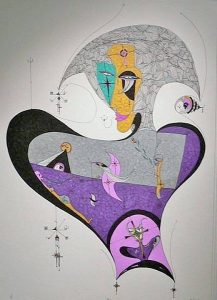 We have previously talked about Helge Segrov's ambivalence in his expressions in our interpretation. In "Springtime voyage" we find it in the main subject that can both symbolize a boat and a bird; spesifically a swan. In "Death of this world for the birth of the new " it is difficult to say whether the main subject is a human or a bird, because the human-like subject is located within the body of a bird, while "growing" out of the ground. In addition to having an ambivalence in itself, it is also a surrealistic expression. Looking at the work "Reeborn" from 2004, we find a head, which can be seen both en face and in profile, giving two quiet different expressions. Another artist who also used this duality in his portraits is Picasso, another artist Helge Segrov is inspired by, but here a lot of similarity stops, because while Picasso drew portraits out in almost distorted and built them up using cubism shapes, Segrov pulls his portraits out in the decorative with their coordinated colours and organic forms.
We have previously talked about Helge Segrov's ambivalence in his expressions in our interpretation. In "Springtime voyage" we find it in the main subject that can both symbolize a boat and a bird; spesifically a swan. In "Death of this world for the birth of the new " it is difficult to say whether the main subject is a human or a bird, because the human-like subject is located within the body of a bird, while "growing" out of the ground. In addition to having an ambivalence in itself, it is also a surrealistic expression. Looking at the work "Reeborn" from 2004, we find a head, which can be seen both en face and in profile, giving two quiet different expressions. Another artist who also used this duality in his portraits is Picasso, another artist Helge Segrov is inspired by, but here a lot of similarity stops, because while Picasso drew portraits out in almost distorted and built them up using cubism shapes, Segrov pulls his portraits out in the decorative with their coordinated colours and organic forms.
This ambivalence we can find in Helge Segrov's expressions allows for infinitely many more interpretations, which beside all the symbolism, makes this art so grateful to use in teaching. In addition, it is more than enough if one wish to go deeper into interpretation of the art.
More images created by Helge Segrov with permission of the artist
1: "Sisterly love" (2015) 2: "A taste of life" (2015) 3: "Self-portrait, on the third eye of the new world" (2006), 4: "Gabriel" (2004) 5: "Hero" (2015), 6: "Thoughts of hope" (2015), 7: "Self-portrait, going back" (2006), 8: "unwanted artist" (1999/2015), 9: "subconcious minds" (2015), 10: "darkness of the hidden truth" (2015), 11: "My angel in dark times" (2015), 12: "Unborn dreams" (2006), 13: "my house of black or white" (2015), 14: "Woman without evil" (2004), 15: "Time of the swan" (2004), 16: "Leaving her cocoon" (2015), 17: "Seeking love" (2015), 18: "When time will come" (2006), 19: "Golden angel" (2015), 20: "Karma" (2015) 21: "Equilibrium" (2015)Referanser [ + ]
